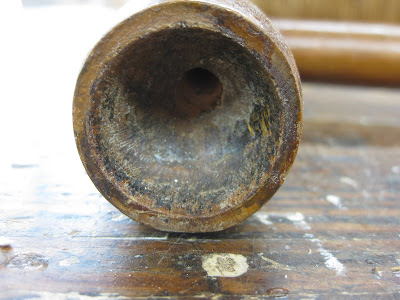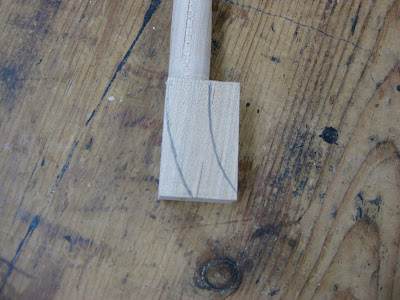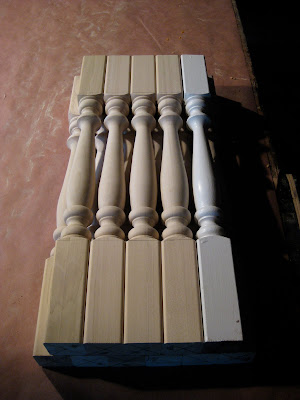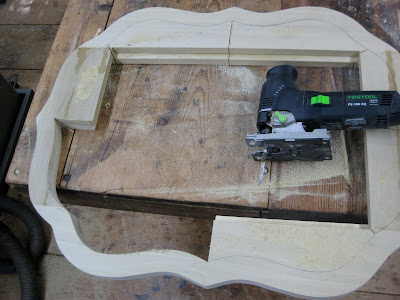
Note: This Blog post was first written as a guest Blog for the Windsor Institute, Mike Dunbar's school of chairmaking in Hampton, NH.
I have been spending a lot of time over the past year studying and making, what is known at The Windsor Institute (TWI) as, the Nantucket Fan Back chair (NFB). But I have not been making copies of The Institute's chair, I have been measuring and reproducing originals from museum collections.
The Winterthur Museum and Country Estate in Wilmington, Delaware commissioned me to reproduce a Nantucket-made High Fan-Back Arm Chair in their collection branded “C. Chase.” The museum wanted the reproduction chair for the exhibition titled “Harbor and Home, Furniture of Southeastern Massachusetts, 1710 – 1850”. The exhibition opened at Winterthur in March and moved to the Nantucket Whaling Museum in July, where it will remain until November 3, 2009.

A nearly identical chair with Chase’s brand is in the collection at Colonial Williamsburg. Other type Windsor’s are also known with his brand. Charles Chase was a house joiner and chairmaker in Nantucket, active between 1780 and 1820.
The NFB chair, also known as a High Fan-Back Arm Chair, is the period chairmaker’s tour de force. You will find one gracing the cover of Nancy Goyne Evans’ tome “American Windsor Chairs.” They are highly sought after by collectors and bring consistently high prices at auction, owing to their beauty, comfort and scarcity. Design elements include a large seat, turned stiles and arm supports, bracing spindles with joined tailpiece, carved knuckles, and volute-carved ears on a steam-bent crest.
The design for the NFB came originally from Philadelphia, where chairmaker’s for decades had been making a High-Back Arm Chair, based on earlier English designs, known at TWI as a Philadelphia High Back. Owing to the extensive sea trade between the Quaker port communities of Philadelphia, New Bedford, and Nantucket, it is no surprise that these chairs were exported to New England. Philadelphia chairs have been found on Nantucket with long histories of island ownership.
In the Fan Back Arm Chair, the arm bow of the earlier chair was eliminated and structurally replaced by two stiles to which the sawn arms are attached at mid-length and the crest at the top. This change eliminated the need for a long steam-bent arm bow and resulted in a more comfortable chair, provided with an array of flexible spindles cradling the sitter’s back. The addition of two bracing spindles allowed the chairmaker to increase the slope of the back, further increasing comfort. These were clearly designed as easy chairs for relaxing or reading versus the more upright and/or armless chairs used for working, dining and/or garden seating.
One of the most interesting design developments in the NFB over the Philadelphia chair is in the seat. The seats on the Philadelphia chairs were smaller and more round in shape with an integral coffin-shaped tailpiece to support the bracing spindles. Typically the grain is diagonal on these poplar seats. By laying the seats out in this fashion, the chair would benefit from the strength of front to-back grain in the tailpiece with less waste using a narrower board.
Nantucket-made chairs feature a larger oval-shaped pine seat with the grain running side-to-side. A tailpiece with grain perpendicular to the seat is joined with a substantial pinned mortise and tenon joint. This method of joinery was a significant development in the Nantucket chair as it allowed for a larger seat utilizing 16-inch instead of 22-inch wide boards. Even in the eighteenth century, clear, 2-inch thick, wide pine was scarce and costly, particularly on an island 28 miles out in the Atlantic Ocean. Indigenous original growth forest timbers had been long felled by this time. It is likely that Charles Chase’s training as a house joiner was the source of this timber-framing joint in his chair. Other island makers soon followed his lead.
Last winter, I was commissioned by the Nantucket Historical Association to reproduce a pair of chairs from one in their collection, made originally on Nantucket by Frederick Slade in about 1799. This chair differs from others of this type in that it has more cylindrical-shaped stiles, separated by a series of rings above and below the arms, a larger crest, and very unique carved knuckles on the arms. It is also more upright than most other examples of this type.

Just recently I was asked by Winterthur to reproduce one of the Philadelphia High-Back Arm Chairs in the their collection that is most closely related to the Nantucket examples. I look forward to measuring and photographing this chair to compare it to the Nantucket example with which I am familiar.

I feel extremely fortunate to have the opportunity to measure and reproduce magnificent examples of a single form of chair and to understand the regional characteristics and differences among makers within a region.


















































